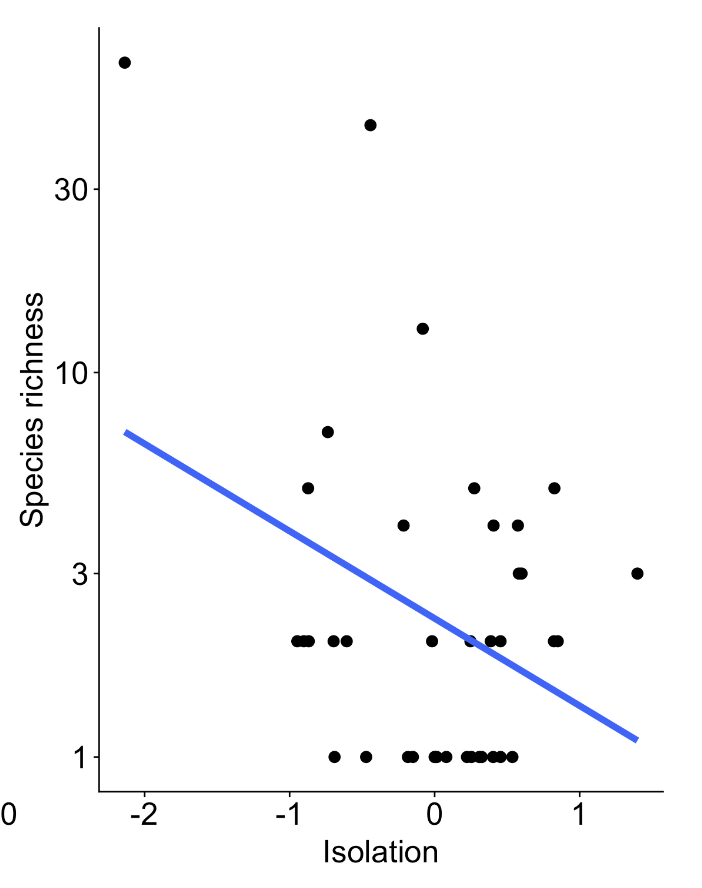Lecture 22: Community ecology: dispersal, metapopulations, and island biogeography
1/37
There's no tags or description
Looks like no tags are added yet.
Name | Mastery | Learn | Test | Matching | Spaced |
|---|
No study sessions yet.
38 Terms
Why is dispersal important?
allows organisms to colonise new areas
allows organisms to escape competition
allows organisms to avoid inbreeding depression
Why is dispersal important for helping organisms escape competition?
If an individual is born into a high density population, with very little resources, it might face strong competition for resources.
But if the individual disperses and colonises into a new habitat with a lower population density and more resources, it can escape competition.
Define inbreeding depression.
A term that refers to the negative consequences of mating with a relative.
Why is dispersal important for helping organisms avoid inbreeding depression?
If a species never goes anywhere, those individuals have a higher probability of mating with a relative, since there’s a lot of related individuals in the habitat.
However, if they can disperse to a new habitat, they can meet more non-relative individuals and mate with them instead. Thus, helping them avoid inbreeding depression.
How do plants accomplish seed dispersal if they can’t move?
Plants have evolved sweet and bright fruits, and other structures around their seeds, to attract animals who will help disperse their seeds.
This is done via eating the fruit and then dropping the seed, or eating the seed too and then pooping it out - also dispersing it.
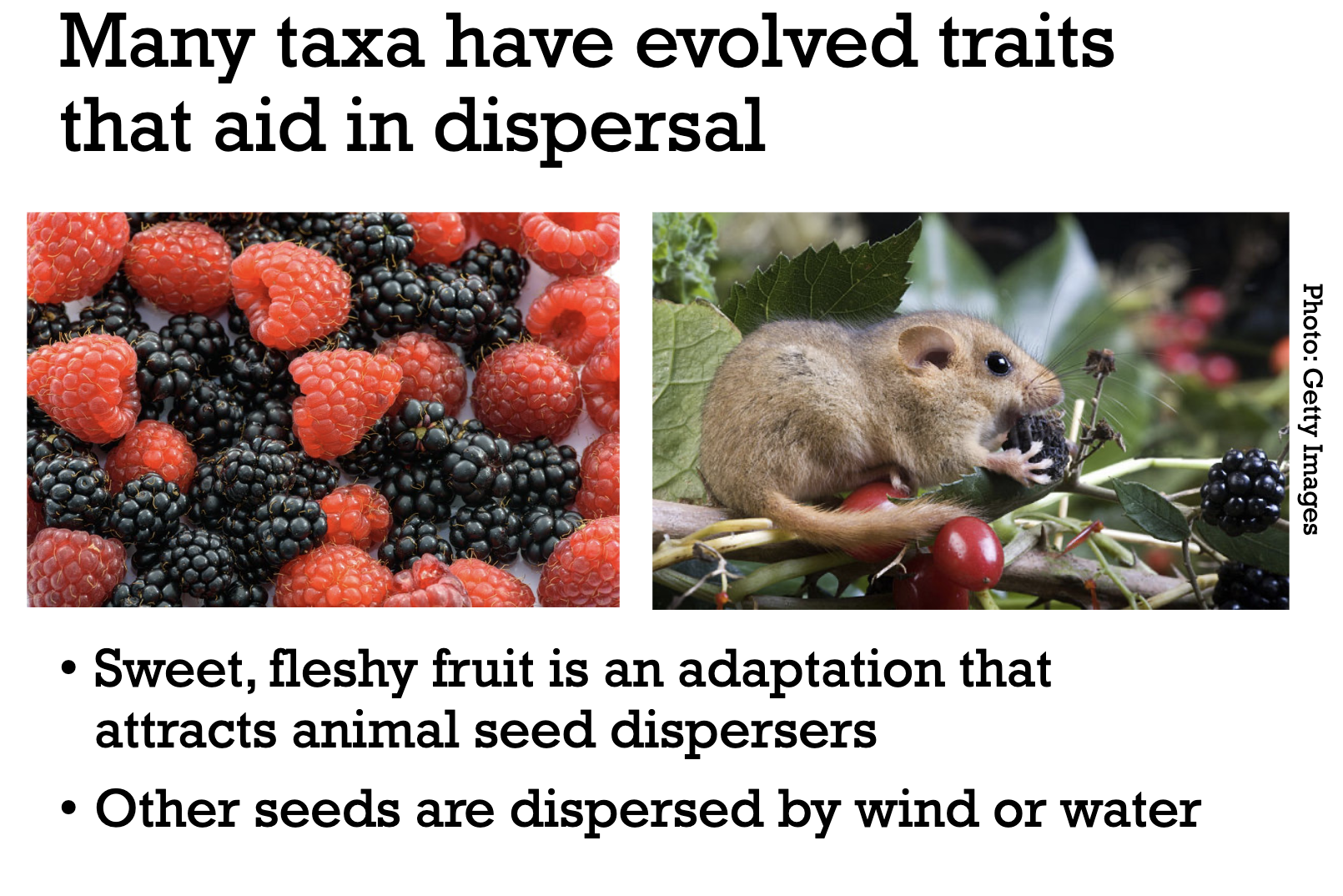
Why else is dispersal important?
Climate change might make it necessary for plants to live in different ranges
Connects separate populations
Define metapopulation (aka. patch).
A group of sub-populations of the same species that are separated by space but interact with each other.
How do metapopulations help populations survive?
Local populations can be restored by colonists from the other sub-populations in the metapopulation through source-sink dynamics.
For example, ‘sinks’ are populations in small patches that would go extinct. However, migrants from ‘source’ populations restore them.
What are the population dynamics like on oceanic islands?
Prey colonises an empty island
Since there are no predators, the prey quickly grows towards its carrying capacity
Not too long later though, some number of predators arrive on the island. Upon the predators’ arrival, they notice that there’s a bunch of prey.
The predators then drive the prey to extinction
The predators then starve and the island becomes empty again
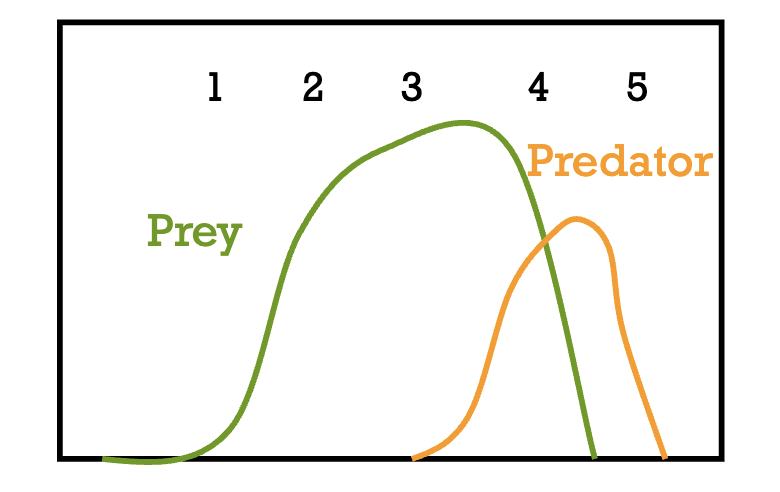
Are the local population dynamics on oceanic islands stable? Why or why not?
No.
Because the prey goes extinct due to predation. Then the predators go extinct because there’s no more prey.
How do oceanic islands survive in real life then if the local system is so unstable?
Dispersal.
If the populations are connected by dispersal, the populations near extinction can be restored by the populations still doing ok on another island.
Hence, a group of locally unstable populations can be globally stable with the help of dispersal.
What are the population dynamics of patches?
They are the same as population dynamics on oceanic islands, but it tracks patch occupancy rather than individuals in a population.
Imagine a large number of identical patches
Ignore the population size within the patches
The populations within the patches go extinct at a constant rate of e
Colonisation of the patches is affected by 2 things
the fraction of currently occupied patches, P (High P means more sources for the colonisers)
the fraction of empty patches, 1-P (as more patches fill up, there are fewer patches available to be colonised)
Thus, the colonisation rate is cP(1-P) where c is a constant
What does the Levin’s patch occupancy model do?
It models the rate of change in patch occupancy over time through the use of a differential equation.
How do you calculate the fraction of occupied patches at equilibrium?
If you know e and c, you can find P. See image.
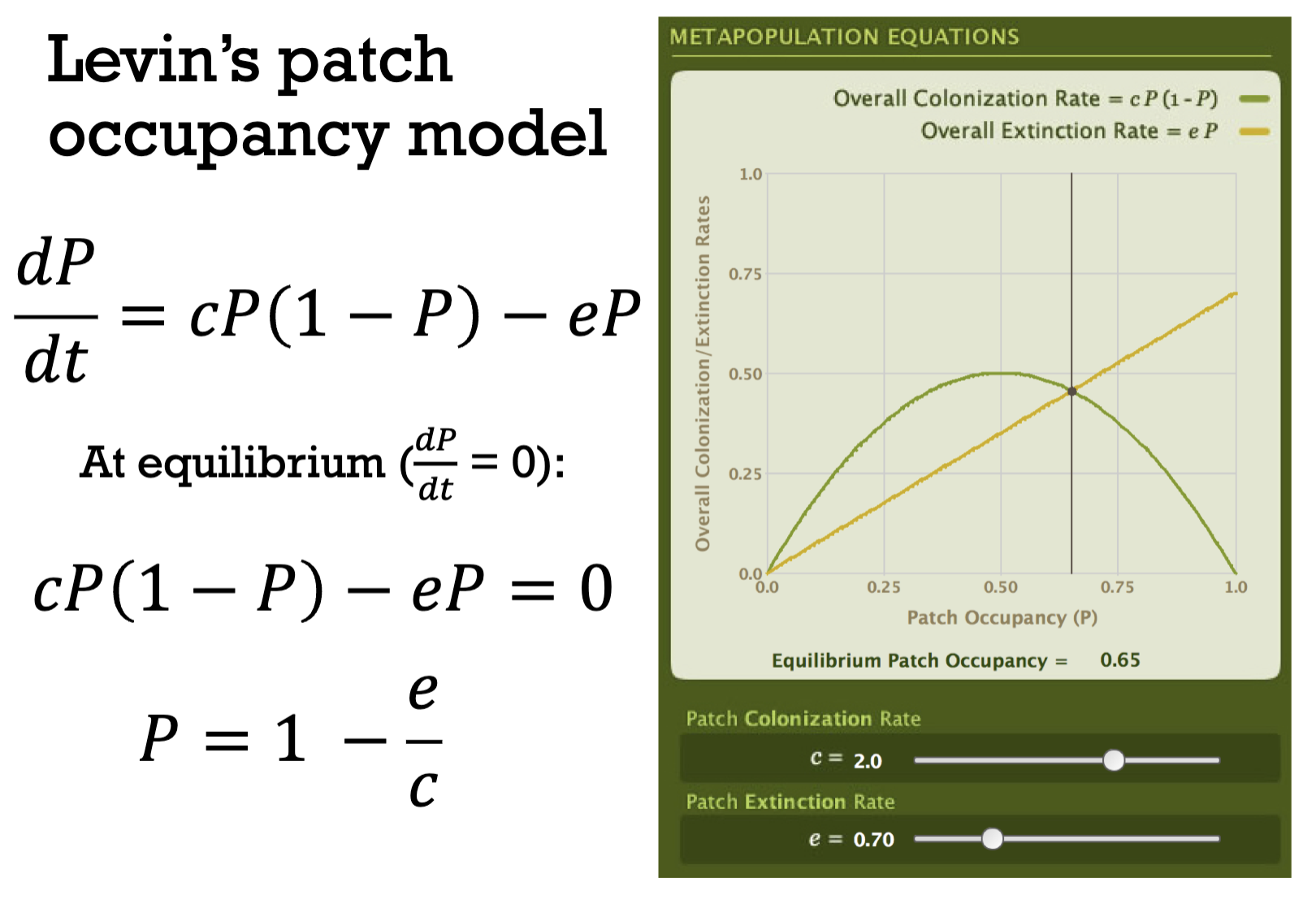
How does patch occupancy affect extinction rates in a population?
When more patches are occupied, more patches go extinct.
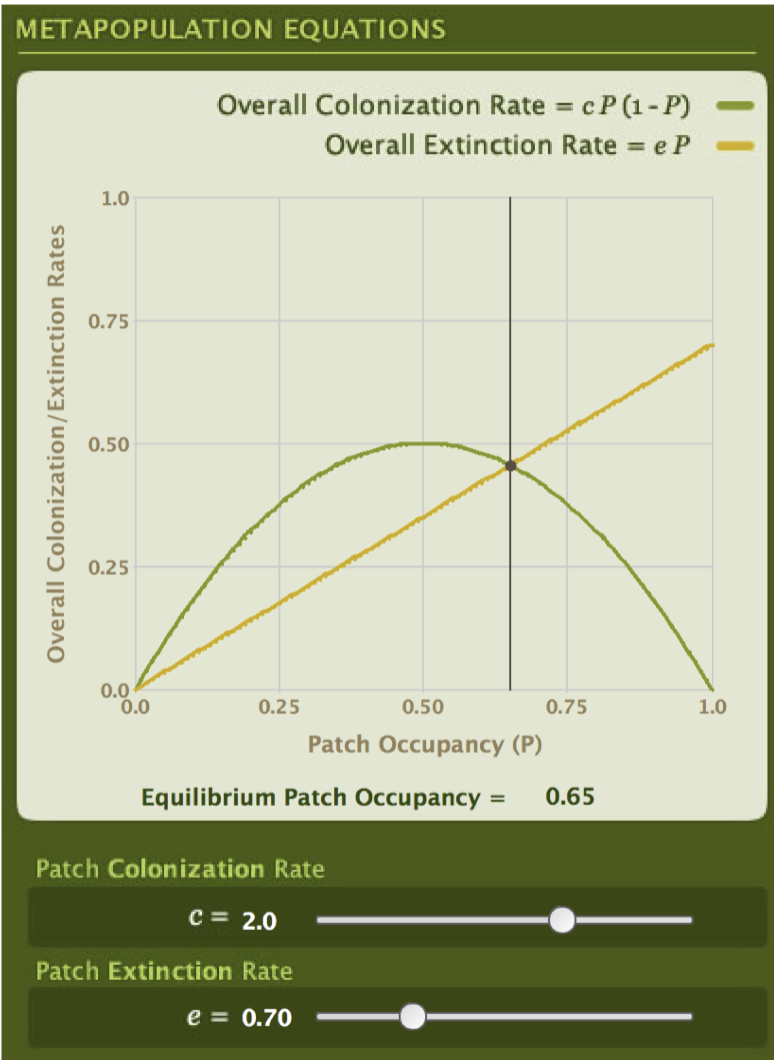
How does patch occupancy affect the colonisation rate in a population?
When patch occupancy is 0, that means that all the populations in the metapopulation are 0. Hence, the colonisation rate must also be 0 since there are no colonisers from the populations present.
When patch occupancy is 1, that means all the patches are full. Hence, the rate of colonisation must also be 0 since colonisers cannot colonise full populations
When the patch occupancy is somewhere in the middle, the colonisation rate is the highest. This is because there are patches that have been colonised and patches that are still empty. Hence, populations can send their colonists to colonise the empty patches.
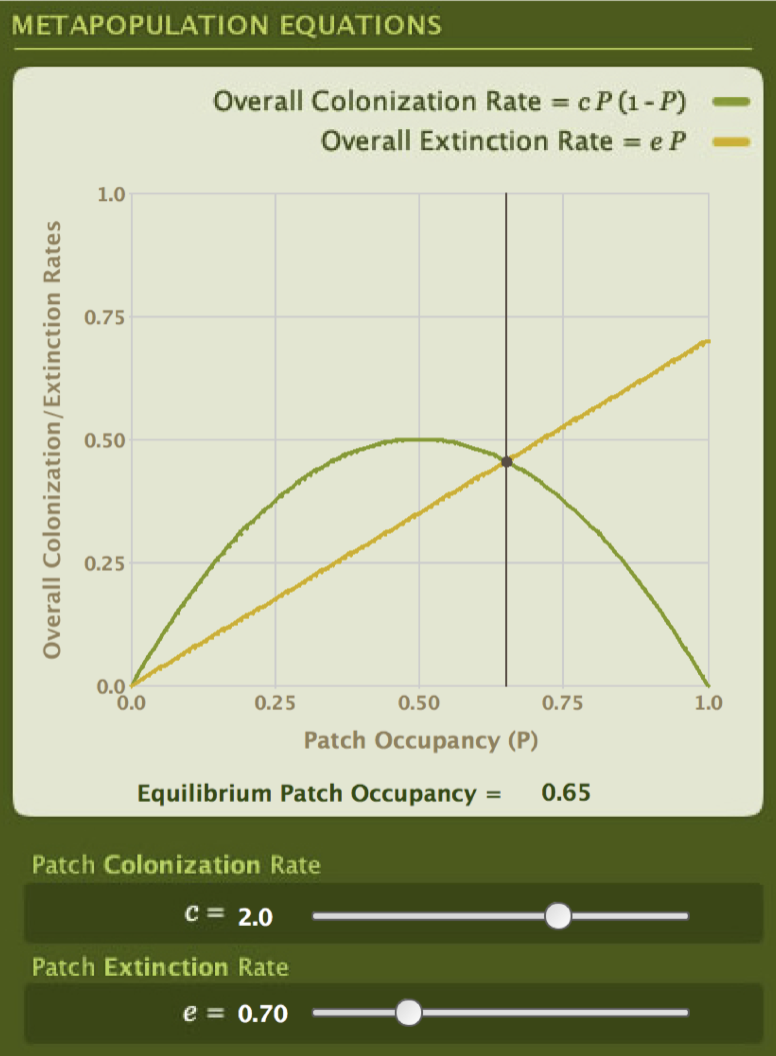
What is the equilibrium path occupancy point?
When the extinction rate and colonisation rate are equal to each other. Therefore, empty patches are gaining individuals through colonisation at the same rate that colonised patches are losing individuals due to extinction.
Therefore, the proportion of occupied patches is no longer changing at that point.
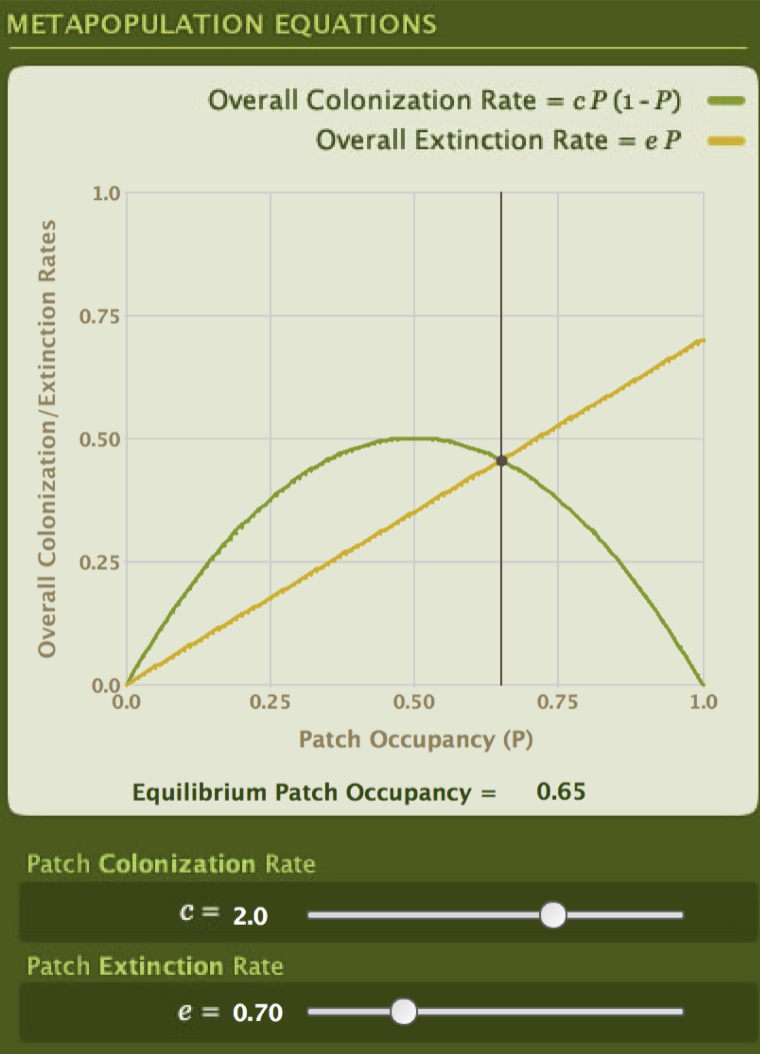
If species A always outcompetes species B in a patch, making local coexistence impossible, is global coexistence possible?
Yes.
How is global coexistence possible if local coexistence is not possible?
There are a few requirements:
Species A must sometimes go extinct in a patch so that there is an empty patch OR a new patch must be made so that there is an empty patch
Thus, species B must be a better disperser than species A so that it can create a large population in the empty patches and live there until species A arrives
Hence, as long as species B continually colonises empty patches and grows well in the absence of species A, it can still thrive, even if it’s always outcompeted locally. Thus, species B must be ‘opportunistic’
This is called a competition-colonisation trade-off. Species A is a good competitor and species B is a good coloniser. Yet, they can both coexist in a metapopulation even if the good competitor will always eventually drive the good coloniser extinct in the local patch.
What is the patch occupancy like for Pika’s from Bodie, California?
Northern areas have the highest patch occupancy of Pika’s. Middle area has the lowest patch occupancy. Southern area has a declining patch occupancy.
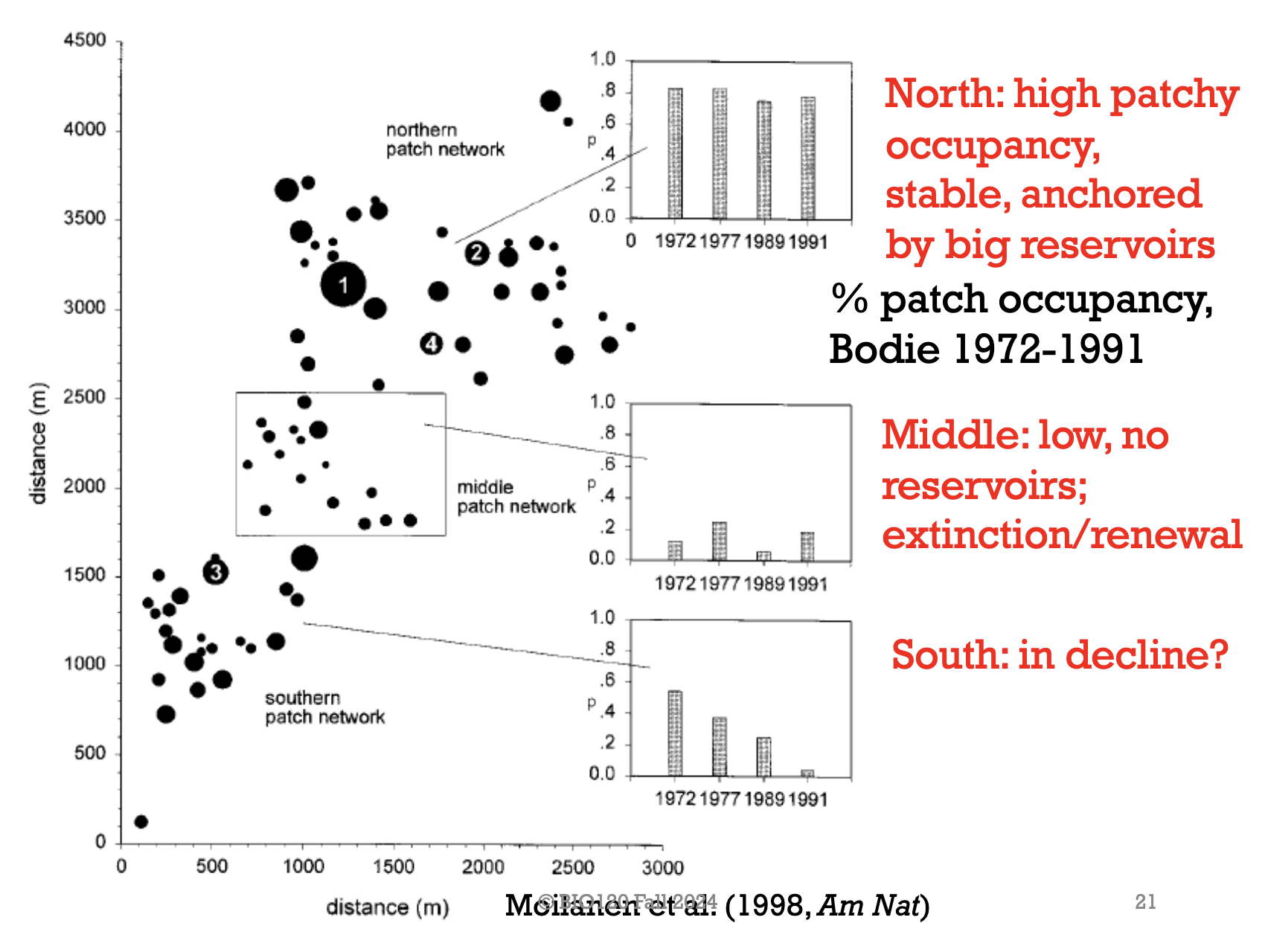
What did scientists predict from Pika data from Bodie, California?
First, they restricted the dispersal of the Pika’s from the different regions.
They then found that the patch occupancy in the northern regions were not affected by lack of dispersal.
Whereas, they found that the persistence of patch occupancy in the middle region is dependant on dispersal.
However, in the southern region, the patch occupancy was very unstable with the lack of dispersal. Even though it took longer, the Pikas eventually went extinct.
*highlights source sink dynamics
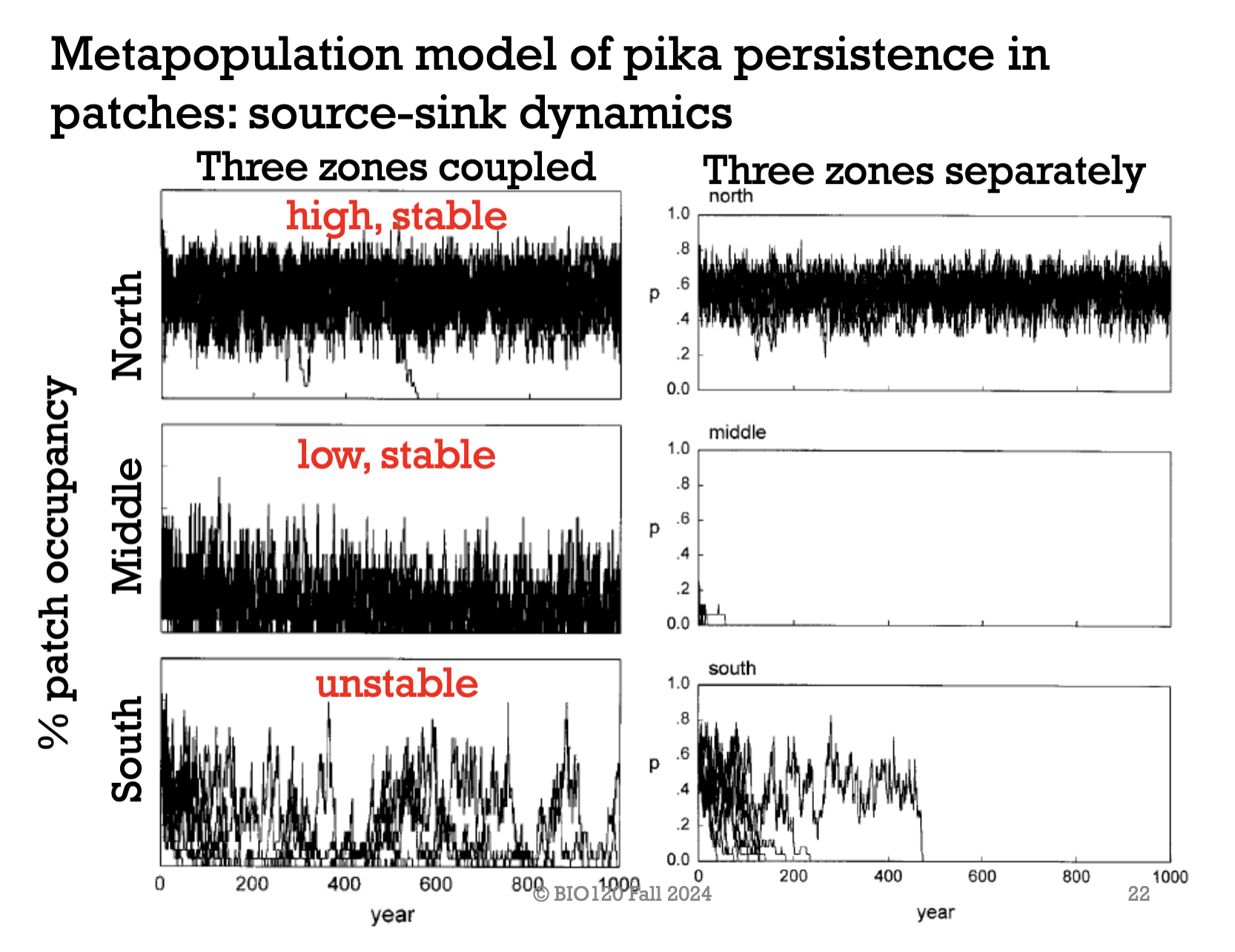
What are the ways in which populations can be driven to extinction?
Stochasticity
Competitive exclusion
Predator-prey interactions
Allee effects at low density
Define stochasticity.
Random fluctuations in population dynamics where, just by chance, the population goes extinct (genetic drift is a stochastic event).
How are the mechanisms that drive populations to extinction countered?
Predation prevents competitive exclusion from going to completion (seen in Paine’s sea star removal)
Rescuing nearly extinct populations via dispersal/migration
Having variation in life-history strategies
Creating non-equilibrial conditions
Habitat patchiness
Define metacommunity.
A set of local communities that are linked by the dispersal of other important species.
What determines the number of species living on an island?
Colonisation
Extinction
In-situ Speciation
How does colonisation affect the number of species living on an island?
A species can arrive on the island from elsewhere and increase the population size.
How does extinction affect the number of species living on an island?
A species may go locally extinct on the island and decrease the population size.
How does in-situ speciation affect the number of species on an island?
A lineage can split into two new species on the island. This would then increase the population size.
However, this is a super slow process, so we’re gonna ignore it.
What theory did MacArthur and Wilson come up with?
The theory of island biogeography.

What was the goal of the theory of island biogeography?
To be able to predict the number of species on an island based on the island’s size and isolation (distance from the mainland).
*they also ignored in-situ speciation
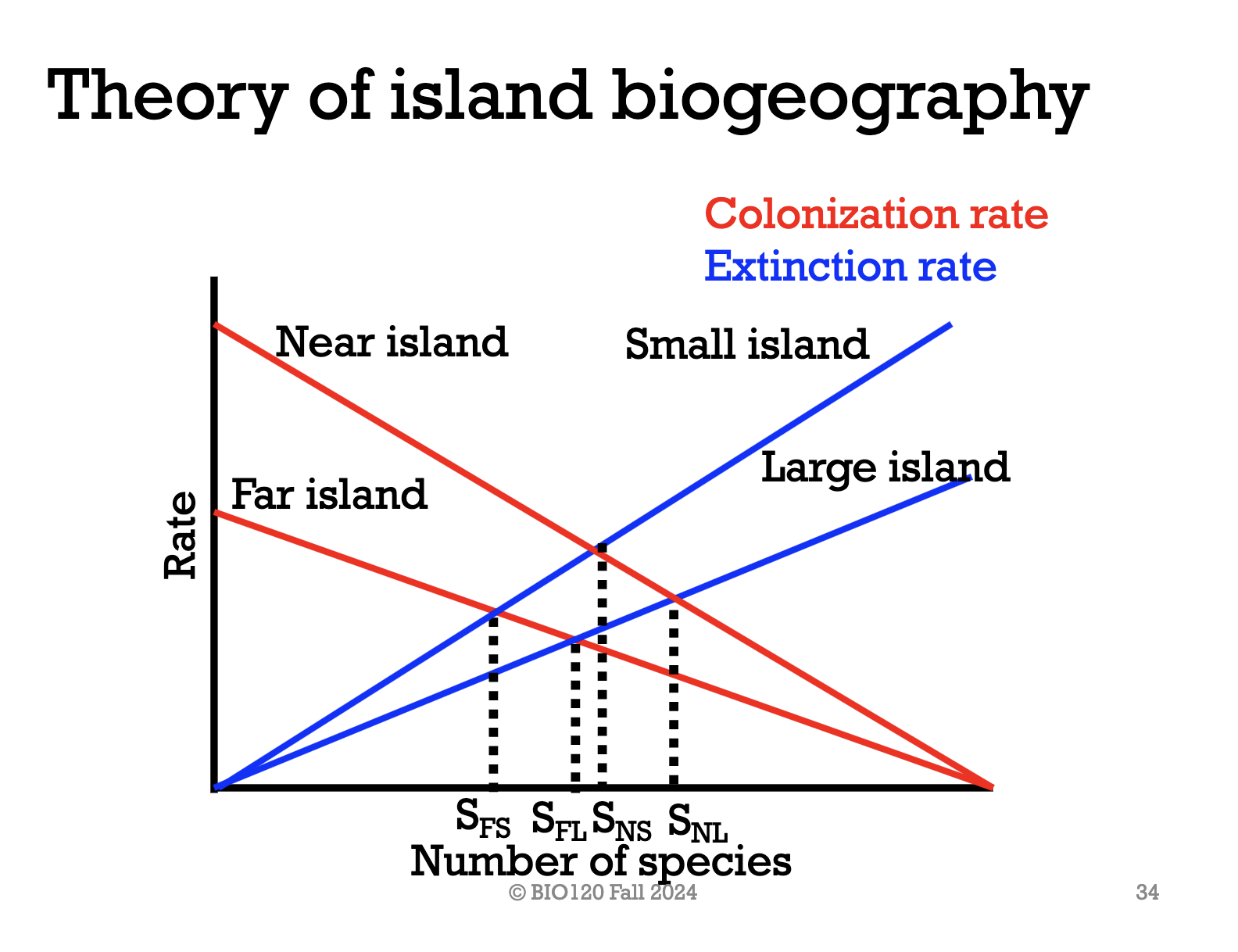
Using the theory of island biogeography, how are the number of species on the island related to the colonisation rate?
As the number of species increases on the island, the colonisation rate decreases.
This is because when there are lots of species already on the island, there is a lower chance that the coloniser will be a brand new species.
However, when a coloniser arrives onto an island with very little species, there’s a much higher chance that the species will be the only one of its kind.
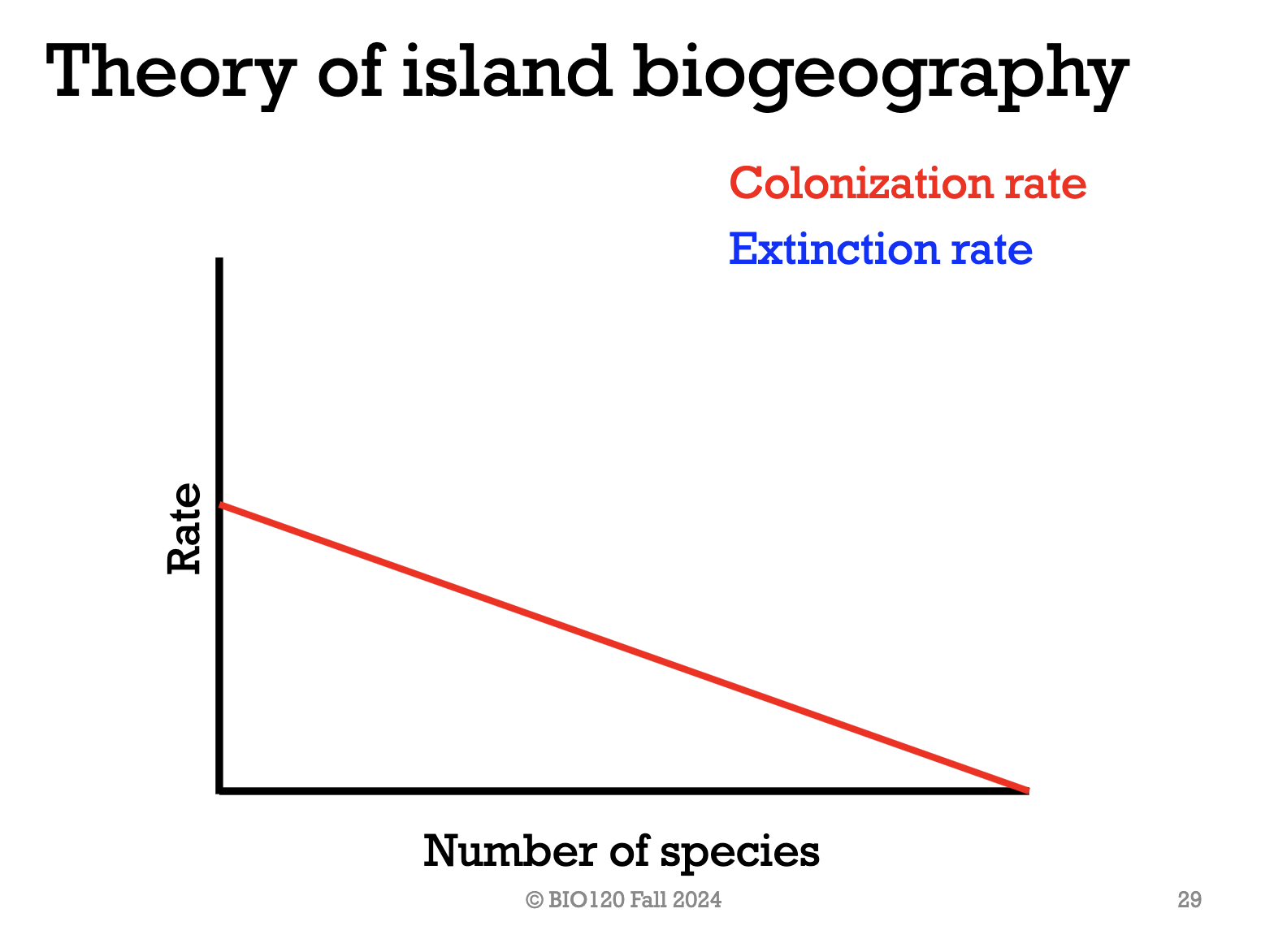
Using the theory of island biogeography, how are the number of species related to the extinction rate?
The more species there on the island, the higher the extinction rate becomes.
This is because with more species on the island, competition for resources becomes intense, which will likely drive some species to extinction.
*same as Levin’s patch occupancy model.
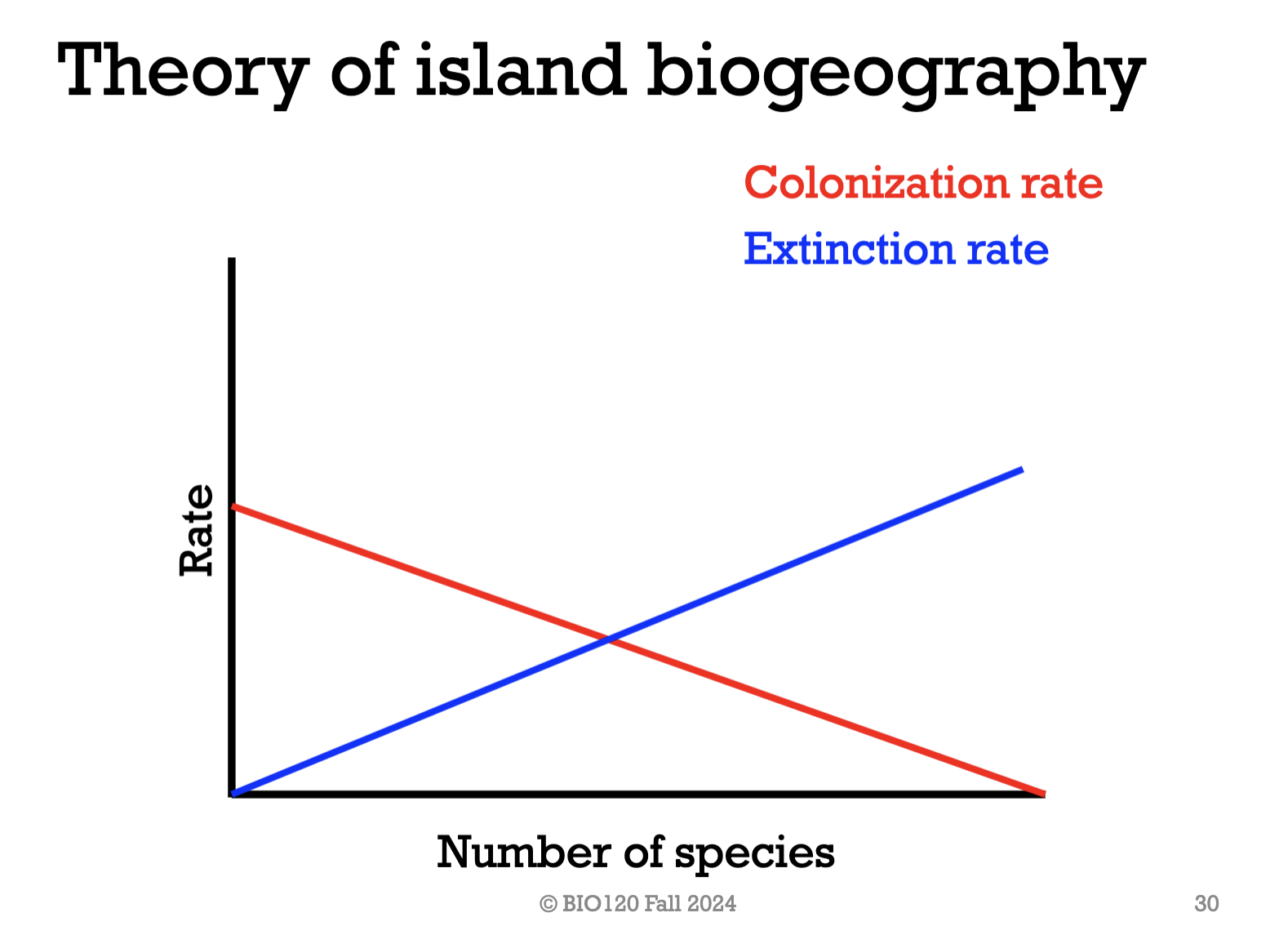
What happens when the colonisation and extinction rate are equal?
The island is gaining species at the same rate the island is losing species. Therefore, the number of species on the island stops changing.

How does distance from the mainland affect the colonisation rate and the number of species who are present at equilibrium?
The closer the island is to the mainland, the higher the colonisation rate and the bigger the population size at equilibrium.

How does the size of the island affect the extinction rate and the number of species who are present at equilibrium?
The smaller the island the greater the extinction rate because smaller islands have fewer resources than larger islands. Also, the number of species present at equilibrium is lower.
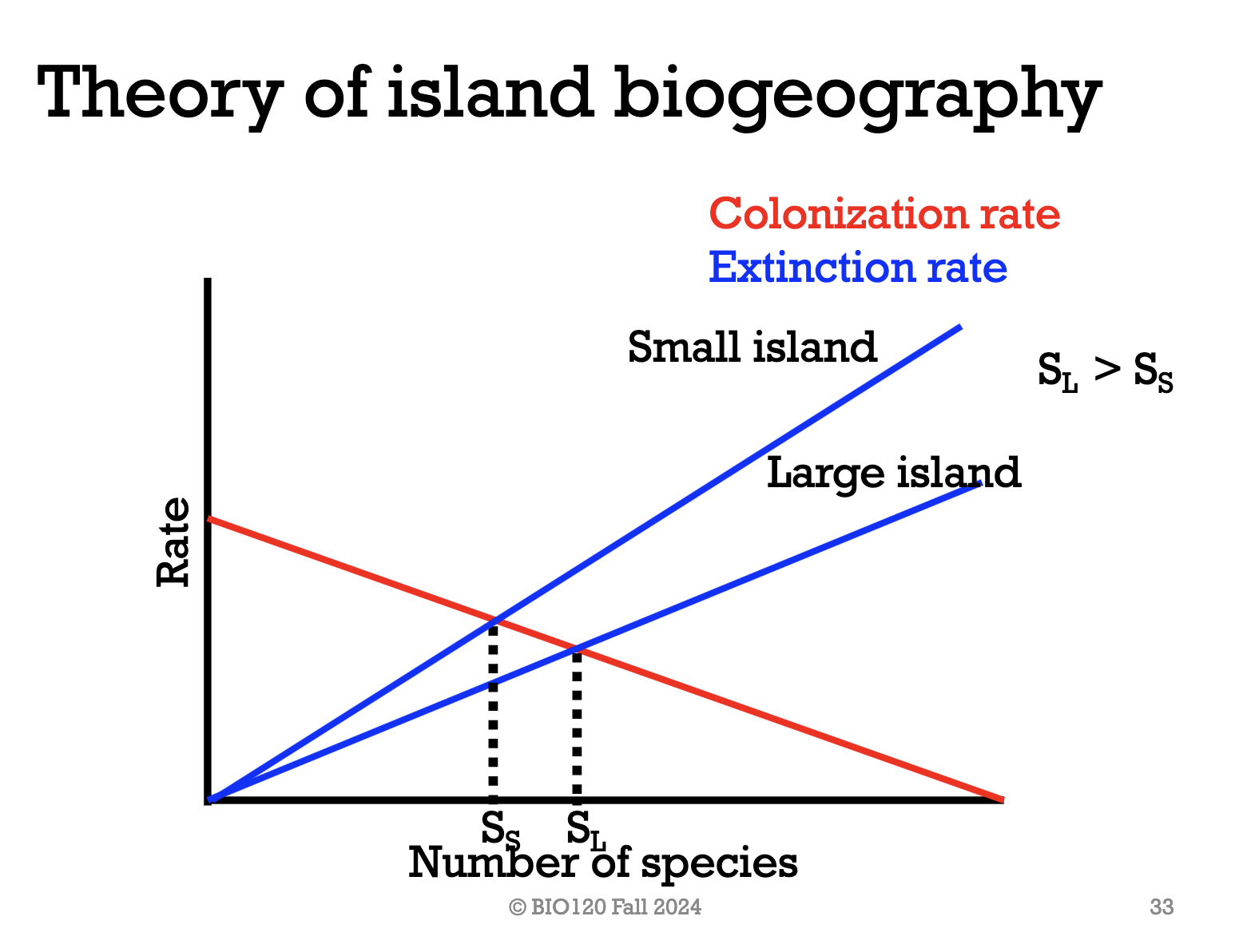
How does area affect species richness of Anolis Lizards?
Species richness increases with area.
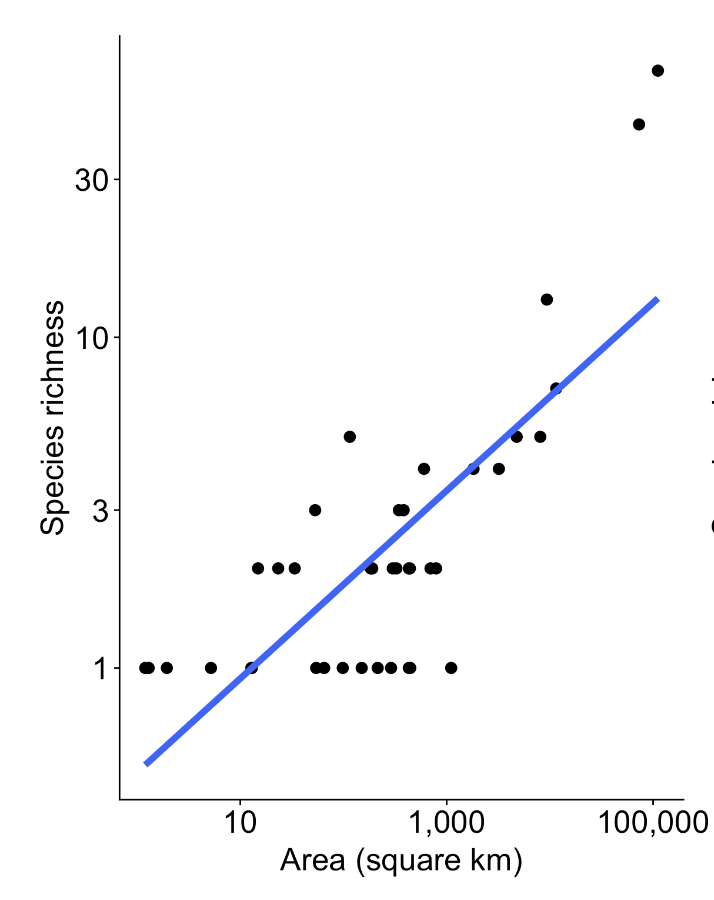
How does isolation affect species richness of Anolis Lizards?
Species richness decreases with isolation.
